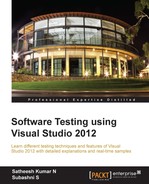Book Description
Learn different testing techniques and features of Visual Studio 2012 with detailed explanations and real-time samples
- Using Test Manager and managing test cases and test scenarios
- Exploratory testing using Visual Studio 2012
- Learn unit testing features and coded user interface testing
- Advancement in web performance testing and recording of user scenarios
In Detail
Testing is one of the main phases in the software development lifecycle. Managing the test scenarios, test cases, defects, and linking each one of these is bit of a challenge without using any tools. For frequently changing businesses, it is essential to address testing requirements by matching the pace of the business. This can only be achieved through automation of the possible testing scenarios to reduce the turnaround time of testing.
Software Testing Using Visual Studio 2012 is a practical, hands-on guide that provides a number of clear, step-by-step exercises, which will help you to take advantage of the new features and real power of Visual Studio 2012.
Software Testing Using Visual Studio 2012 starts with the basics of testing types and managing the tests using Test Explorer and a few other tools. Practical examples are added to help you understand the usage of various tools and features in a better way. Software Testing Using Visual Studio 2012 is written from a developer point of view and helps you take advantage of the unit testing features and customize the tests by generating the code and fine-tuning it as per your needs. The Test Manager is a standalone tool which is part of the Visual Studio tools family and takes care of test management. Software Testing Using Visual Studio 201 covers the usage of the test plan, test suite, manual testing, and exploratory testing using Test Manger and managing these aspects using these tools.
Software Testing Using Visual Studio 2012 also covers the recording of user actions and creating automated tests out of it. This book covers generating and adding parameters to the recording and replacing it at runtime, adding validation and extraction rules to the tests, running the tests using command line commands, looking at the details of test results, and configuring the running the load test out of web performance or unit tests.
This book helps you to understand the complete testing features and how to make use of automation features as well. It will appeal to both developers and testers.
Table of Contents
- Software Testing using Visual Studio 2012
- Table of Contents
- Software Testing using Visual Studio 2012
- Credits
- About the Authors
- About the Reviewers
- www.PacktPub.com
- Preface
- 1. Visual Studio 2012 Test Types
- 2. Test Plan, Test Suite, and Manual Testing
- 3. Automated Tests
- 4. Unit Testing
- Creating unit tests
- Assert statements
- Types of Asserts
- Downloading the example code
- CollectionAssert
- CollectionAssert.AllItemsAreNotNull
- CollectionAssert.AreEquivalent
- CollectionAssert.AreNotEquivalent
- CollectionAssert.AllItemsAreInstancesOfType
- CollectionAssert.IsSubsetOf
- CollectionAssert.IsNotSubsetOf
- CollectionAssert.AllItemsAreUnique
- CollectionAssert.Contains
- CollectionAssert.DoesNotContain
- CollectionAssert.AreEqual
- ollectionAssert.AreNotEqual
- AssertFailedException
- UnitTestAssertionException
- ExpectedExceptionAttribute
- CollectionAssert
- Unit Tests and Generics
- Data-driven unit testing
- Unit Testing using Fakes
- Code coverage unit test
- Summary
- 5. Web Performance Test
- 6. Advanced Web Testing
- 7. Load Testing
- Creating a Load Test
- Load Test Wizard
- Editing Load Tests
- Storing results in central result store
- Running the Load Test
- Analyzing and exporting Test Results
- Using Test Controller and Test Agents
- Summary
- Creating a Load Test
- 8. Ordered and Generic Tests
- 9. Managing and Configuring Tests
- 10. The Command Line
- 11. Working with Test Results
- 12. Exploratory Testing and Reporting
- 13. Test and Lab Center
- Index
